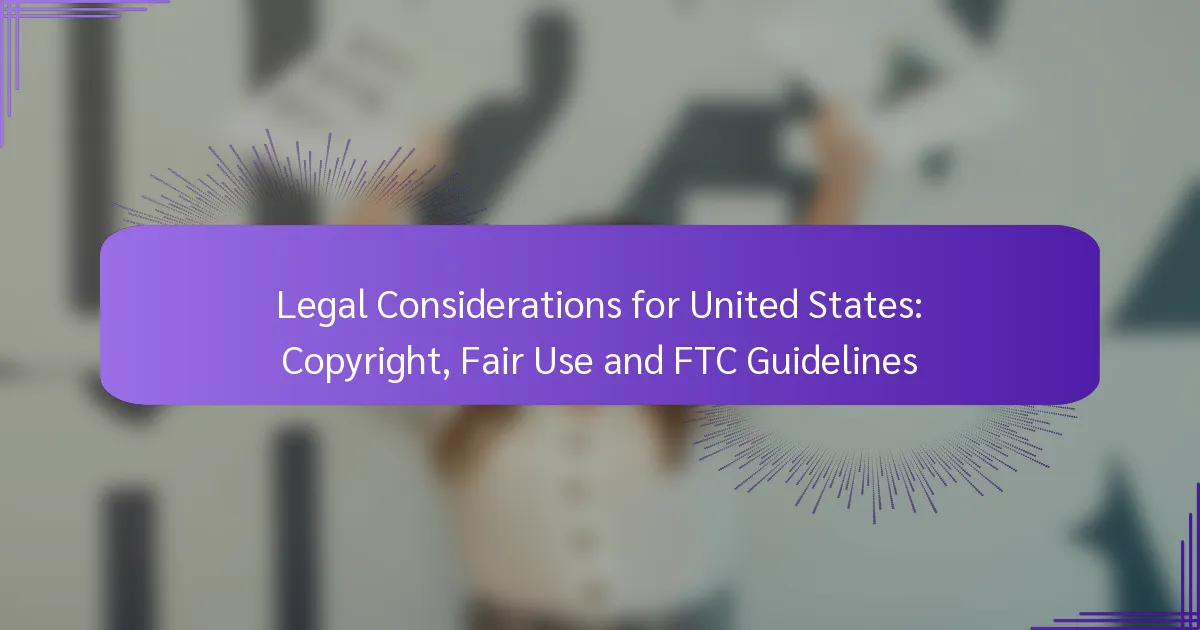Understanding the legal landscape of copyright, fair use, and FTC guidelines is essential for creators and businesses in the United States. Copyright laws protect intellectual property, while fair use allows limited use of copyrighted materials under specific conditions. Additionally, adhering to FTC guidelines ensures transparency and honesty in digital marketing practices, safeguarding both consumers and brands.
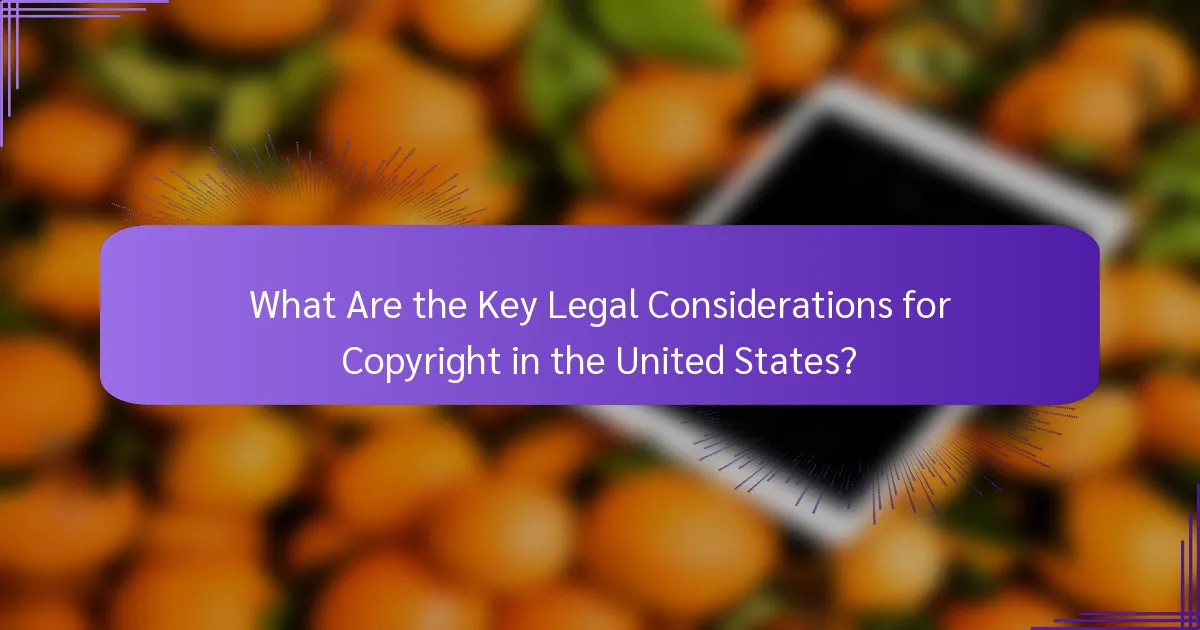
What Are the Key Legal Considerations for Copyright in the United States?
Key legal considerations for copyright in the United States include understanding the definition of copyright, its duration, the registration process, the consequences of infringement, and notable cases that have shaped copyright law. These elements are crucial for creators and businesses to protect their intellectual property and navigate potential legal challenges.
Definition of Copyright
Copyright is a legal right that grants the creator of original works exclusive control over the use and distribution of their creations. This includes literary, musical, and artistic works, as well as software and other digital content. Copyright protection arises automatically upon the creation of a work, provided it is fixed in a tangible medium.
Duration of Copyright Protection
The duration of copyright protection in the United States typically lasts for the life of the author plus 70 years. For works created by corporations, the duration is generally 95 years from publication or 120 years from creation, whichever is shorter. After the expiration of copyright, the work enters the public domain, allowing anyone to use it without permission.
Registration Process for Copyright
While copyright protection is automatic, registering a work with the U.S. Copyright Office provides legal advantages, such as the ability to sue for infringement and eligibility for statutory damages. The registration process involves completing an application form, submitting a copy of the work, and paying a fee, which can range from $35 to $85 depending on the type of work.
Consequences of Copyright Infringement
Copyright infringement can lead to significant legal consequences, including monetary damages, injunctions, and the potential for statutory damages that can reach tens of thousands of dollars per infringement. In severe cases, willful infringement may result in criminal charges. It is crucial for individuals and businesses to ensure they have the right to use copyrighted material to avoid these penalties.
Notable Copyright Cases
Several landmark cases have shaped copyright law in the United States. For example, the case of *Campbell v. Acuff-Rose Music, Inc.* established the fair use doctrine, allowing limited use of copyrighted material without permission under certain circumstances. Another significant case, *Google LLC v. Oracle America, Inc.*, addressed the copyrightability of software and its implications for the tech industry. These cases highlight the evolving nature of copyright law and its impact on creators and users alike.
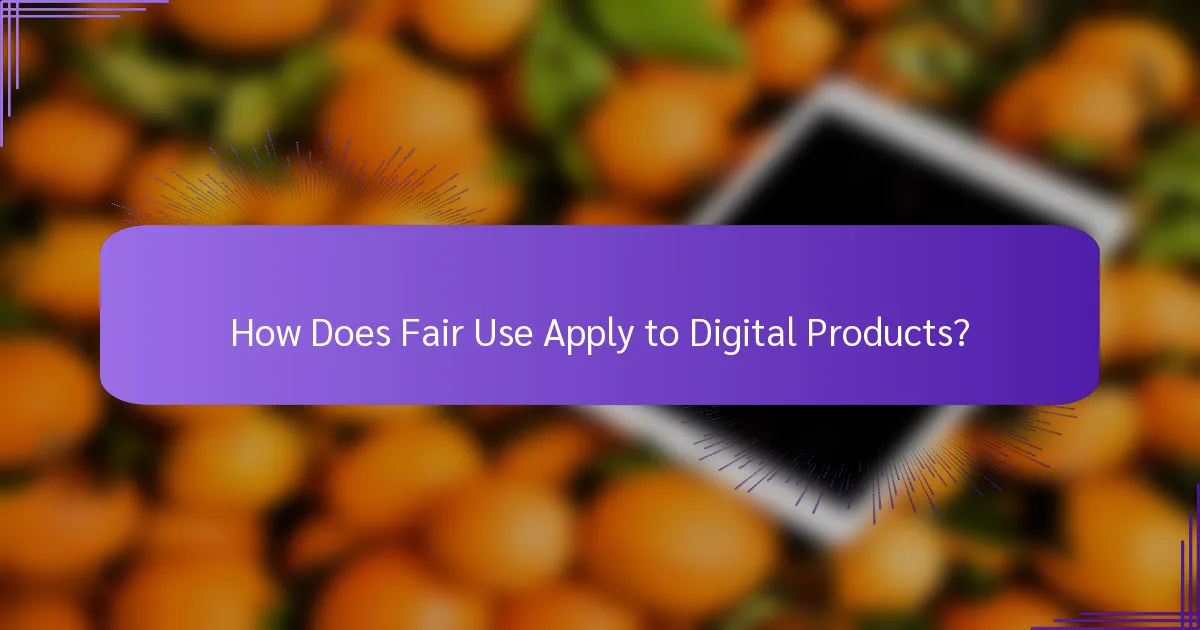
How Does Fair Use Apply to Digital Products?
Fair use allows limited use of copyrighted material without permission, particularly in digital products. This legal doctrine is crucial for creators, educators, and businesses to understand how they can use existing works while minimizing legal risks.
Definition of Fair Use
Fair use is a legal principle that permits the use of copyrighted material under certain conditions without requiring permission from the copyright holder. It is designed to balance the interests of copyright owners with the public’s interest in the dissemination of information and creativity.
In the context of digital products, fair use can apply to various forms of content, including text, images, and videos, as long as the use meets specific criteria outlined in copyright law.
Factors Determining Fair Use
Four primary factors determine whether a use qualifies as fair use: the purpose of the use, the nature of the copyrighted work, the amount used, and the effect on the market value of the original work. Each factor is weighed individually, and no single factor is determinative.
For instance, transformative uses that add new meaning or message are more likely to be considered fair use. Conversely, using a substantial portion of a work for commercial purposes may weigh against fair use.
Examples of Fair Use in Digital Media
Common examples of fair use in digital media include using short clips from films for commentary or criticism, incorporating quotes from books in educational materials, and creating mashups or parodies that transform the original work.
Another example is a blog that discusses a recent news event and includes a brief excerpt from a news article. As long as the excerpt is not excessive and serves a specific purpose, it may qualify as fair use.
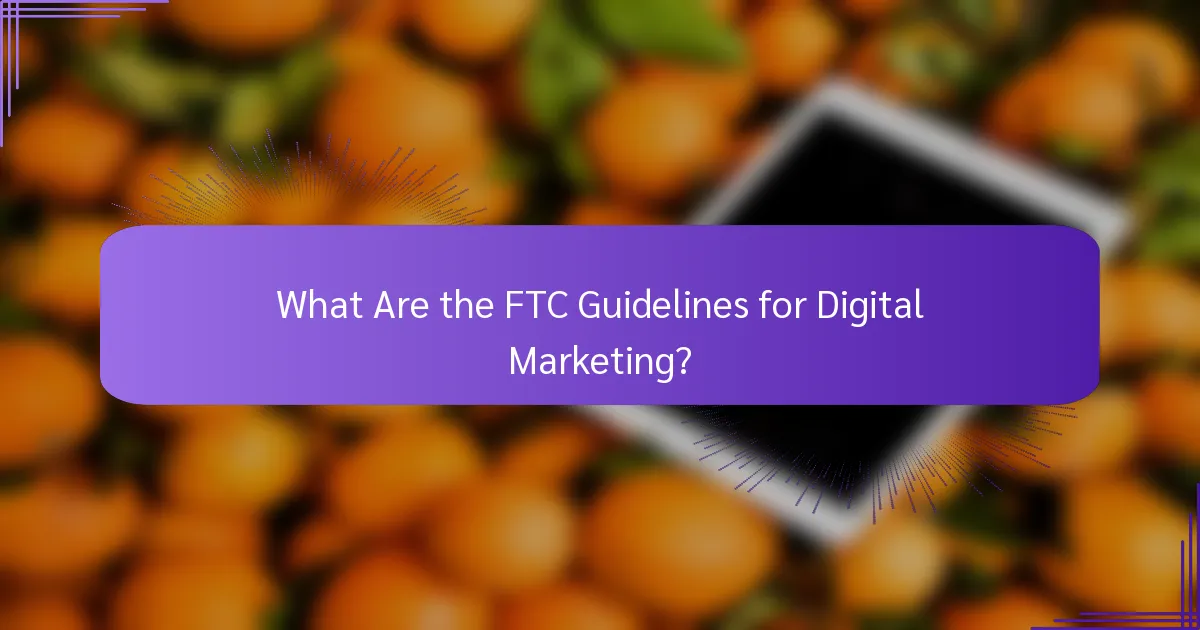
What Are the FTC Guidelines for Digital Marketing?
The FTC guidelines for digital marketing are regulations that ensure transparency and honesty in advertising practices. These guidelines require marketers to disclose their relationships with brands and ensure that endorsements are truthful and not misleading.
Overview of FTC Guidelines
The FTC guidelines apply to all forms of advertising, including social media, blogs, and other digital platforms. They aim to protect consumers by requiring clear and conspicuous disclosures when there is a material connection between an endorser and the brand being promoted. This means that if a marketer is compensated or receives free products, they must disclose this relationship to their audience.
Marketers should ensure that their disclosures are easy to understand and placed in a location where consumers can easily see them. For example, using clear language like “paid partnership” or “sponsored content” can help clarify the nature of the endorsement.
Disclosure Requirements for Influencers
Influencers must disclose any material connections with brands when promoting products or services. This includes financial compensation, free products, or any other incentives. The disclosure should be made in a way that is noticeable and understandable, such as placing it at the beginning of a post or video.
Using hashtags like #ad or #sponsored is common, but influencers should ensure that these disclosures are not buried in a long list of hashtags or links. The goal is to make it clear to the audience that the content is sponsored.
Consequences of Non-Compliance
Failure to comply with FTC guidelines can lead to significant consequences, including fines and legal action. The FTC has the authority to impose penalties on brands and influencers who do not adhere to these regulations, which can range from thousands to millions of dollars depending on the severity of the violation.
Additionally, non-compliance can damage a brand’s reputation and erode consumer trust. Marketers should regularly review their practices to ensure they are following the guidelines and avoid potential pitfalls that could lead to enforcement actions.
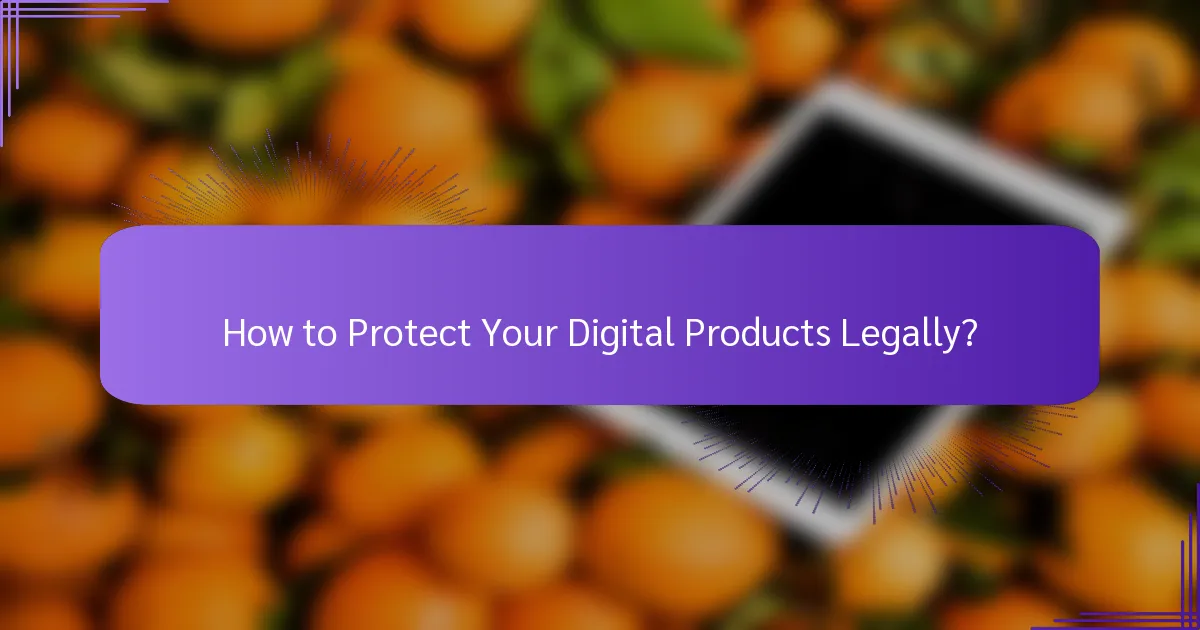
How to Protect Your Digital Products Legally?
To protect your digital products legally, you should understand copyright laws, fair use principles, and FTC guidelines. These frameworks help ensure that your intellectual property is safeguarded while allowing you to navigate the complexities of content sharing and marketing.
Best Practices for Copyright Protection
Copyright protection is essential for safeguarding your digital products, such as e-books, software, and online courses. To secure your rights, consider registering your work with the U.S. Copyright Office, which provides legal advantages in case of infringement.
Additionally, always include copyright notices on your products to inform users of your ownership. Use clear terms of service and licensing agreements to specify how others can use your content, which can help prevent unauthorized use.
Steps for Ensuring Fair Use Compliance
Fair use allows limited use of copyrighted material without permission under certain conditions. To ensure compliance, evaluate the purpose of your use, the nature of the copyrighted work, the amount used, and the effect on the market value of the original work.
For example, using a short excerpt for commentary or criticism may qualify as fair use, while using a substantial portion for commercial purposes likely does not. Always document your reasoning and consider seeking legal advice if unsure about specific uses.
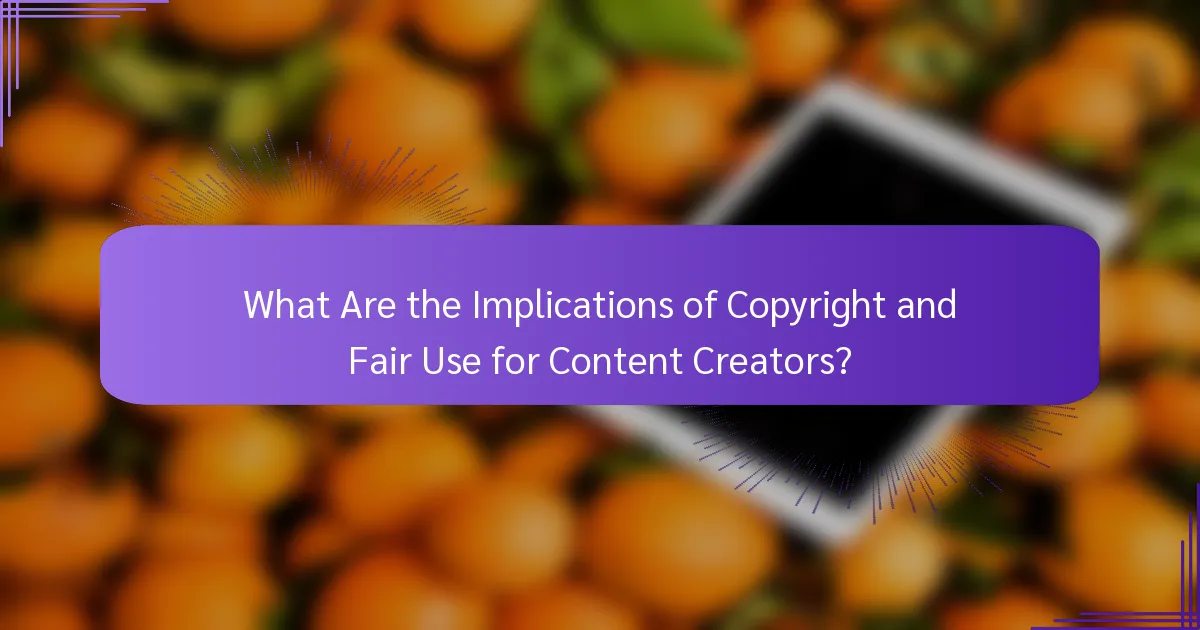
What Are the Implications of Copyright and Fair Use for Content Creators?
Copyright and fair use significantly impact content creators in the United States by defining how original works can be used and shared. Understanding these concepts helps creators avoid legal pitfalls while maximizing their creative potential.
Impact on Content Creation
Copyright grants creators exclusive rights to their original works, including the right to reproduce, distribute, and display them. This protection encourages innovation but can restrict how others use similar content. Fair use allows limited use of copyrighted material without permission under certain conditions, such as criticism, comment, news reporting, teaching, or research.
For example, a blogger may quote a few lines from a book for commentary purposes, but using an entire chapter would likely infringe copyright. Content creators should be aware of the balance between protecting their work and the opportunities fair use provides for engagement and discussion.
Strategies for Navigating Legal Risks
To minimize legal risks, content creators should familiarize themselves with copyright laws and fair use guidelines. Keeping track of sources and obtaining permissions when necessary can help avoid disputes. Additionally, creators can consider using Creative Commons licenses, which allow others to use their work under specified conditions.
When in doubt, creators should seek legal advice or consult resources like the U.S. Copyright Office. A practical strategy includes documenting the purpose and context of any borrowed material, as this can support a fair use claim if challenged.
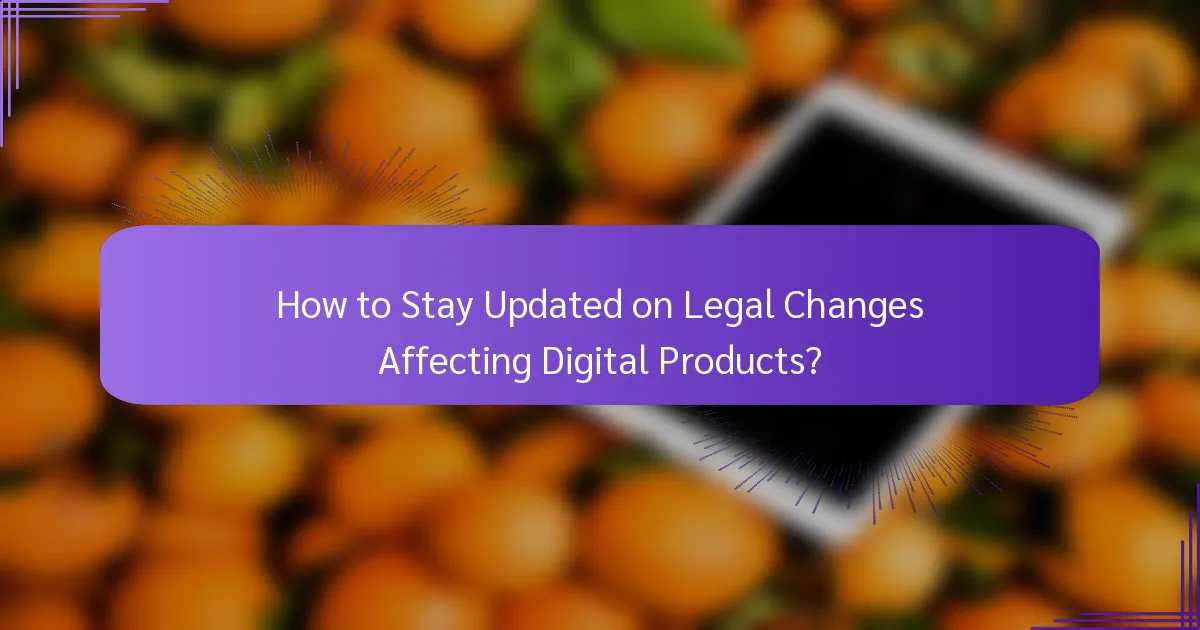
How to Stay Updated on Legal Changes Affecting Digital Products?
To stay informed about legal changes impacting digital products, regularly consult reliable sources such as government websites, legal blogs, and industry publications. Subscribing to newsletters and following relevant social media accounts can also provide timely updates.
Follow Relevant Legal Blogs and Websites
Legal blogs and websites dedicated to copyright, fair use, and FTC guidelines are essential resources. Websites like the Electronic Frontier Foundation (EFF) and the Copyright Office offer insights and updates on legislative changes and case law. Regularly visiting these sites can help you understand the implications of new laws on your digital products.
Subscribe to Newsletters and Alerts
Many legal firms and organizations provide newsletters that summarize recent developments in digital law. Subscribing to these newsletters ensures you receive curated information directly in your inbox. Additionally, setting up Google Alerts for specific legal terms can help you track changes as they happen.
Attend Webinars and Conferences
Participating in webinars and conferences focused on digital law can enhance your understanding of current trends and legal challenges. These events often feature expert speakers who discuss recent cases and regulatory changes. Networking with other professionals can also provide insights into how they navigate legal considerations.
Engage with Professional Associations
Joining professional associations related to digital media, technology, or law can be beneficial. These organizations often provide resources, training, and updates on legal matters affecting digital products. Engaging with peers in these associations can also facilitate discussions about best practices and compliance strategies.
